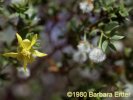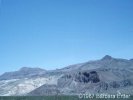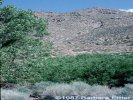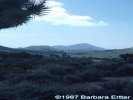 Carl Purpus, Plant
Collector in Western America
Carl Purpus, Plant
Collector in Western America 
by C. A. Purpus
Daunt, Tulare County, August 1897
 Carl Purpus, Plant
Collector in Western America Carl Purpus, Plant
Collector in Western America | Report of My Journey in the Southern Sierra Nevada and the Argus and Madurango Ranges (Continued) |
 | by C. A. Purpus |






|
Original Title: Bericht uber meine Tour in die sudliche Sierra Nevada und die Argus und Madurango Ranges Von C. A. Purpus, Daunt, Tulare Co. im August 1897. Mitt. Deutsch. Dendrol. Ges. 6: 313-318.
|
 Joshua Tree
Woodland near Walker Pass. Joshua Tree
Woodland near Walker Pass. Other Articles: Collecting in the Sierra Nevada: 0170 On the Trail…: 0300 Locations: Walker Pass.
Toward the middle of June we continued our journey, through the valley of the South Fork of the Kern River and over the interesting Walker Pass into the Mojave Desert. We crossed the desert near Indian Wells so that we could explore the Argus Mountains in southeastern California. At the foot of [Walker] Pass I encountered Prunus fasciculata in fruit. I also saw Cercis occidentalis, Fremontia, assorted Compositae, and Salvia carnosa [S. dorrii] here. In sandy spots I found Opuntia basilaris and O. echinocarps, the latter covered with greenish yellow flowers. We then passed a stand of Yucca arborescens that covered a sandy flat, extending to about 4000 feet elevation in the pass. This Yucca stand presented a very interesting, remarkable sight, and gave the landscape a southern character. In the pass I found Juniperus californica, Artemisia tridentata, Purshia glandulosa, and miscellaneous shrubby Compositae. Farther on Forestiera neomexicana appeared as well, along with Yucca arborescens, which ascended nearly to 5000 feet, Prunus fasciculata, Pinus sabineana, P.
monophylla, and a suffrutescent Penstemon with lovely flowers.
|
|  Larrea tridentata.
Larrea tridentata.
Yucca arborescens spanned the pass and extended down the slopes to the edge
of the desert, where Larrea tridentata, the characteristic shrub of this region,
began. The other shrubs were those of the western slope, though I missed Prunus
fasciculata here. On the other hand, Lycium andersonii A. Gray, which I had
noticed only sporadically on the west side of the pass, was more abundant. This
interesting shrub was covered with coral-red berries. I often came upon Opuntia
echinocarpa here as well.
|
|  Indian Wells, California.
Indian Wells, California.  North end of Coso Mountains.
North end of Coso Mountains. Other Articles: Collecting in the Sierra Nevada: 0180 On the Trail…: 0310 Locations: Coso Mountains. Indian Wells.
We spent the night on the eastern slope of the pass, close to a willow-shaded spring. The next morning we continued through the sandy area to Indian Wells. To the left rose the wonderfully sculptured peaks of the Sierra, bare or sparsely forested with Pinus monophylla. To the right were the dark, volcanic ridges of the El Paso Range, and to the northeast, the bare peaks of the Argus Mountains and part of the Coso Mountains. Between the reddish gray mountains rose a dark red to black extinct crater, very characteristic of these mountains. The places where the lava had flowed down the the mountain slopes and poured forth onto the plains were very interesting. It looked as if such areas were shaded by clouds while the lighter parts of the mountains were in the full glare of the sun.
|
| The sandy, treeless
plain was covered with Larrea tridentata, not densely
but rather spaced at intervals. This is the dominant shrub of the lower Sonoran
zone in the Mojave Desert. Dalea fremontii Gray, Opuntia echinocarpa,
Lepidospartum, and miscellaneous shrubby Compositae could be seen in many places
between the Larrea. On salty or alkaline areas grew miscellaneous shrubby
Chenopodiaceae with silver-white leaves. I found the interesting Lepidospartum
squamatum Gray around Indian Springs.
|
|  Argus Range across desert.
Argus Range across desert.  Argus Range across desert.
Argus Range across desert. Other Articles: On the Trail…: 0320 Locations: Argus Mountains. Argus Range. Salt Wells. Letters: 10/27/1896
From here we went eastward across the desert. Toward evening we arrived, thirsty and tired, at Salt Wells, a well in the middle of the treeless, waterless waste in a region strongly impregnated with alkali. In the surrounding area grew assorted shrubby Chenopodiaceae, such as Nitrophila, Suaeda, Grayia spinosa, and others. We spent the night here and continued our travels the following morning to the Argus Mountains. Although the mountains appeared to be right next to us, it took us eight hours to reach them.
|
|
 Mountain Springs Canyon, at the Mammoth Mine, Argus Mountains.
Mountain Springs Canyon, at the Mammoth Mine, Argus Mountains.
Locations: Mountain Springs Canyon.
Our first station was at the mouth of Mountain Spring Canyon, at a spot where a willow-shaded spring emerged from the dry streambed. The slopes of the partly volcanic, partly plutonic mountains were covered with shrubs, primarily Larrea but also Lycium andersonii, L. cooperi Gray, Eriogonum, assorted lovely Compositae, and Eurotia lanata. Between these shrubs grew the splendid Echinocactus polycephalus with its rose-red spines, often growing 2-3 feet tall. The Argus Mountains form one of the most interesting ranges in southern California. Innumerable quantities of shrubs, which seldom exceed 3-4 feet in height, cover the often steep slopes of the mountains. They do not form large aggregations, but appear instead as round spots or dots. The range therefore looks like it has a hundred eyes, hence the name "Argus Mountains".
|
|  Argus Peak from the west.
Argus Peak from the west. Locations: Argus Peak.
The only trees were Yucca arborescens and Pinus monophylla, which could be found only on the highest peaks where it formed sparse stands or occurred as isolated individuals. Yucca arborescens appeared in its full splendor, attaining a height of 20-30 feet with a diameter of 2-3 feet or more. It is very characteristic of this ranging and resembles Dracaena draco, forming large
stands. It ascends to over 6000 feet, where, however, it occurs only individually, as on Argus Peak. At an elevation of 6300 feet [actually 6562], Argus Peak in the highest peak in these mountains, if one excludes the Madurango Range, which is geologically distinct from the Argus Range and separated from it by a plateau.
|
| We remained at the
mouth of the canyon for only a few days and then moved our camp to the foot of Argus Peak at an elevation of 5000 feet. Here there were still other shrubs, such as for example Coleogyne ramosissima, Purshia glandulosa, Salazoria mexicana, Penstemon, and Eriogonum. Artemisia tridentata formed the principle bulk of the vegetation.
|
| On an excursion to
Argus Peak I found an interesting Symphoricarpos with
very large, red flowers, a remarkable Amelanchier, and a Ribes. The only tree
was Yucca arborescens. Along a creek I found Forestiera neomexicana in addition
to willows. On an exploration of one of the highest peaks, an extinct crater,
I found the rare Echinocactus polyancistrus with magnificent magenta flowers.
|
|  Maturango Peak from Coso Range, California.
Maturango Peak from Coso Range, California.  Panamint Range and Valley from Argus Range.
Panamint Range and Valley from Argus Range.
Locations: Madurango Range. Panamint Mountains. On a visit to the Madurango Range,
I found Cereus engelmannii, an equally splendid species. The Madurango Range, as I have already mentioned, attains its greatest elevation in Madurango Peak, over 8000 feet high. The view from this peak is magnificent, especially looking eastward to to Panamint Mountains. Pinus monophylla forms continuous stands on the highest summits of this range. I also saw Yucca arborescens between 6500 and 6600 feet. This range is also distinct botanically from the Argus Mountains and has much in common with the Sierran flora. For example, I found Heuchera rubescens here, which also occurs in the Sierra.
|
| Locations: Piute Peak. Letters: 6/24/1897
I remained in the Argus Mountains until the end of June and then backtracked
to Piute Peak, where I collected for two more weeks. I then returned to
Springville on the Tulare River. After a four-week recuperation, I undertook a
new expedition to the springs of the Kaweah River in the Sierra Nevada.
| |
[Previous Page] [Next Page] | |
| [Published Biographies] [Travelogues and Articles] [Letters] [Plant Lists and Bibliography] [Site Administration] | | Date and time this article was prepared: 6/7/2002 7:32:12 PM |